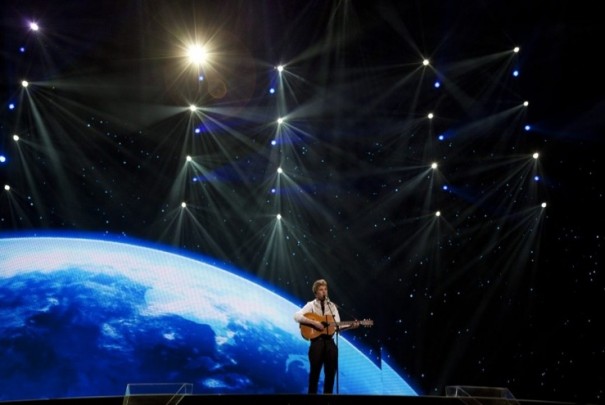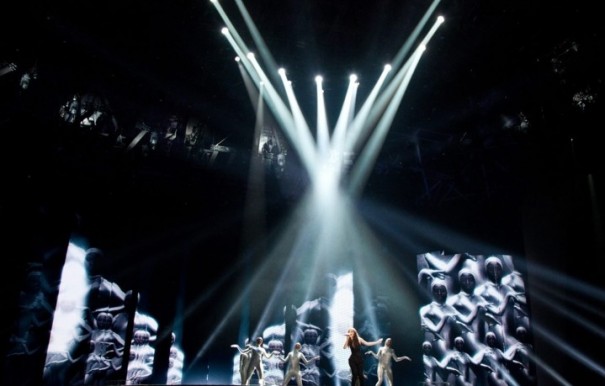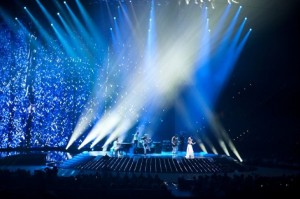La NDR convierte al Festival de Eurovisión en un espectáculo único
Para la realización del Festival de Eurovisión, celebrado el sábado 14 en el Esprit Arena de Dusseldorf (Alemania), la NDR empleó un total de 25 cámaras, incluyendo cuatro cabezas calientes, dos steadycam, una robótica sobre rieles alrededor del escenario circular y una Towercam. Para una visión general de todo el estadio bajo la cubierta, se desplegó una Spidercam que, magistralmente remoteada, ofreció unas planos secuencia únicos.
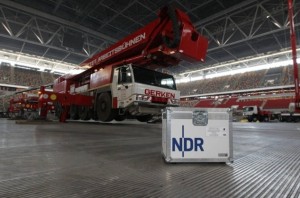 Una audiencia estimada en 125 millones de espectadores siguieron en la noche del sábado 14 desde el Esprit Arena de Dusseldorf uno de los mayores espectáculos audiovisuales del Viejo Continente: el Festival de Eurovisión.
Una audiencia estimada en 125 millones de espectadores siguieron en la noche del sábado 14 desde el Esprit Arena de Dusseldorf uno de los mayores espectáculos audiovisuales del Viejo Continente: el Festival de Eurovisión.
Para la ocasión, la organización desmanteló el césped del estadio disponiendo tarimas en toda la superficie para albergar a los más de 35.000 espectadores que acudieron al Esprit Arena.
El broadcaster anfitrión, la alemana NDR, encargó a Florian Wieder un espectacular escenario de 13 metros de diámetro, conectado a un set adicional, cuyo fondo estaba presidido por una pantalla de LED gigante de 60 metros de ancho y 18 de alto (1.080 metros cuadrados) con un total de 520 paneles LED. Una vez finalizadas las actuaciones, la pantalla gigante se abrió dejando ver una curiosa “green-room” en la que en una especie de colmena los representantes de cada país aguardaban nerviosos la votación de los diferentes jurados.
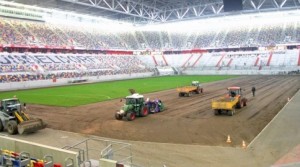 Un total de 35 kilómetros de cableado y ocho generadores diésel eléctricos permitieron alimentar 6 megawatios.
Un total de 35 kilómetros de cableado y ocho generadores diésel eléctricos permitieron alimentar 6 megawatios.
En iluminación, la puesta en escena corrió a cargo del diseñador Jerry Appelt, quien distribuyó magistralmente 2.200 puntos de luz, con un gran despliegue de más de un millar de cabezas móviles robotizadas, instalados sobre siete kilómetros de truss.
La iluminación, junto con la pantalla de LED gigante, ofrecieron un espectáculo único de luz e imágenes personalizadas para cada actuación.
Para la realización del show se emplearon un total de 25 cámaras, incluyendo cuatro cabezas calientes, dos steadycam, una robótica sobre rieles alrededor del escenario circular y una Towercam. Para una visión general de todo el estadio bajo la cubierta, la NDR desplegó una Spidercam que, magistralmente remoteada, ofreció unas planos-secuencia únicos.
Para los hightlight y repeticiones de los momentos más estelares, NDR utilizó la tecnología de EVS. En la producción de Eurovisión se emplearon un total de ocho servidores XT2, uno de ellos ha sido un XT2+ con almacenamiento externo. Esta máquina se reservó exclusivamente para los artistas y sus managers pudiendo chequear en las fases de pre-producción y semifinales el sonido, la luz y la puesta en escena con ayuda de monitorización HD y sonido 5.1. Las otras siete máquinas se reservaron para la grabación del programa y fuentes ISO, distribuyendo la señal a diferentes broadcasters y a los editores encargados de preparar los highlights. Por otro lado, un IPDirector se empleó para el playout simultáneo a las diferentes pantallas a través de diferentes mainframes XT2 y la gestión de contenidos del material grabado (por ejemplo, para ordenar los diferentes ensayos).
En cuanto a audio, este ingente montaje desplegó más de 350.000 watios, empleándose un total de 90 micrófonos Sennheiser de mano y diadema. Entre otros equipos se emplearon 50 Handsender SKM 5200-II con cápsulas Neumann KK 105, 72 SK 5212-II, 40 EM 3732-II, y 15 SR 2050.
En las comunicaciones y la distribución de señales jugó un papel fundamental la tecnología de Riedel Communications, empresa que implentó un versátil sistema que incluía MediorNet, RockNet, Artist y Performer. Gracias a estas soluciones de Riedel, la NDR convirtió un estadio de fútbol de 15.000 metros cuadrados en un gran plató de televisión.
Cuatro consolas Aurus de Stagetec con 48 faders, tres de ellas instaladas en las móviles desplegadas por NDR y una cuarta en la móvil HD, llevaron a cabo todas las mezclas de sonido. Una de las consolas se empleó para la mezcla de música y una segunda para el sonido internacional. La tercera y cuarta se emplearon con backup ante la previsión de cualquier fallo.
Cada sala de control contó con su propia red Nexus para que pudiera funcionar de manera independiente de los demás pudiendo intercambiar datos de audio a través de MADI para formar una sola red de audio. La producción se llevó a cabo en sonido en 5.1 y estéreo de forma simultánea.
Para la cobertura informativa por parte de los 2.500 periodistas acreditados, la UER-EBU dispuso un centro de prensa de 7.000 metros cuadrados.
Jon-Ola Sand, como represenante de la UER-EBU, Thomas Schreiber, por parte de la NDR, y Dieter Thiessen, al frente de la ingeniería pueden estar más que satisfechos porque, pese a las dificultades técnicas que supone un montaje de este tipo, en la gran noche de Eurovisión saliera todo a la perfección en un impecable festival que ganó Azerbaiján con el dúo Ell&Nikki y la canción Running Scared.
Did you like this article?
Subscribe to our NEWSLETTER and you won't miss anything.



